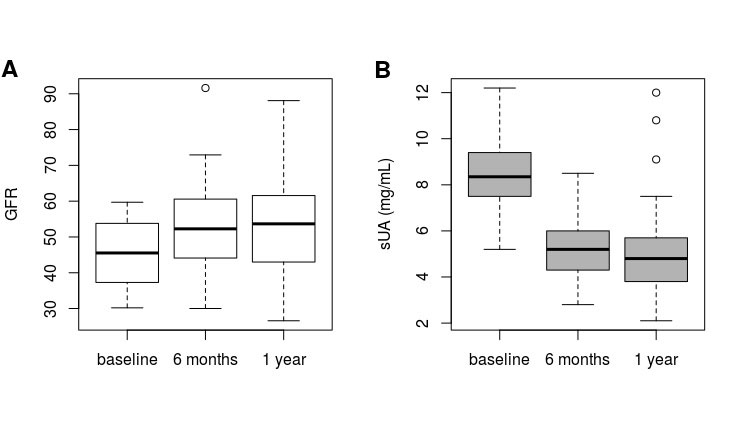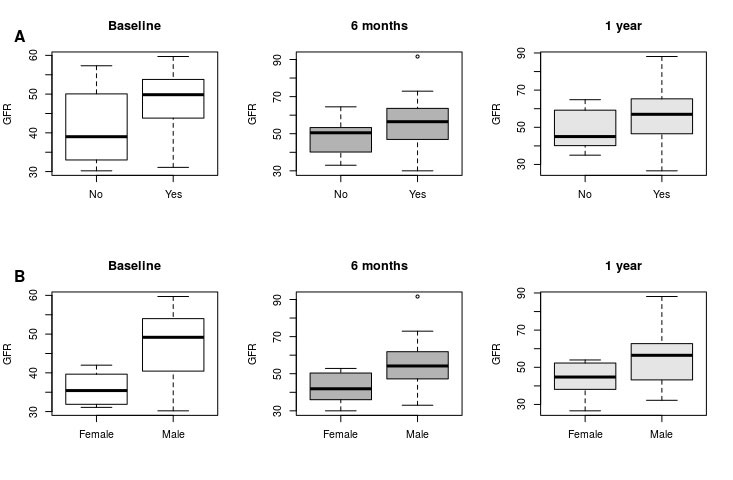Session Information
Session Type: Poster Session (Sunday)
Session Time: 9:00AM-11:00AM
Background/Purpose: Approximately 25% of patients with gouty arthritis suffer from chronic kidney disease (CKD). High serum uric acid (sUA) levels have been related to glomerular filtration-rate (eGFR) imbalance. Beneficial effect of treatment with xanthine oxidase inhibitors (XOI), mostly allopurinol, has already been proved in patients with CKD and asymptomatic hyperuricemia. Although several studies have described the efficacy and renal safety of treatment with XOI in gout, few authors have analyzed the effect of treating gout to target (T2T) on eGFR in patients with gouty arthritis and moderate CKD. Our objective is to assess the effect of treating gout to target in patients with gouty arthritis and moderate CKD, in terms of eGFR changes.
Methods: In this multicenter, longitudinal, observational study, we included patients from 7 different hospitals, between January 2014 and December 2018. All diagnosed with gout (ACR/EULAR 2015 criteria) and stage-3 CKD according to Cockroft-Gault formula (eGFR 30-59 ml/min/m2) who received XOI (febuxostat or allopurinol) with a follow-up for 6 and 12 months. Exclusion criteria were: primary kidney disease, kidney transplantation or single-kidney. Data were provided from clinical records at baseline visit, 6 and 12 months. Those patients whom data were not collected at that schedule were also excluded. Demographic and clinical features included were: age, sex, age at gout onset, pattern of joint involvement, presence of tophi, sUA levels, nephrolithiasis, comorbidities, concomitant treatments, smoking and alcohol intake. Statistical analysis: linear mixed-effects model was used. To fit this model a stepwise approach was adopted considering p-value < 0.05 statistically significant for feature coefficients. Nmlev-3.1-137 R package.
Results: Complete data were obtained from 50 patients (44 males and 6 females). Mean age 72.90±8.94 years. Mean baseline sUA was 8.55±1.57 mg/dl and mean eGFR 45.52±9.21 ml/min/m2. Time, sUA levels, smoking and sex were variables with significant effects according to the linear mixed effects model for eGFR. A significant improvement in eGFR was observed in first 6 months (16.7±5.1 ml/min/m2) (p=0.004), associated to an inverse relation in sUA levels (p=0.04). Non-smokers presented better eGFR than smokers (p=0.01) and males had higher eGFR in all considered points than females (p=0.008). No significant differences were obtained between allopurinol or febuxostat administration regarding eGFR variations.
Conclusion: Reduction of sUA levels in patients with gout and CKD stage-3 treated with XOI following the T2T approach entitles an improvement of eGFR. These findings suggest that the response to urate-lowering treatment takes place in the first 6 months, leading to a significant improvement in eGFR in this period, and both (sUA and eGFR) remain stable between 6 and 12 months. So that, an optimal management of gout can preserve and improve kidney function in patients with arthritis and moderate CKD.
To cite this abstract in AMA style:
Calvo-Aranda e, Novella-Navarro M, CABRERA-ALARCON j, Aramburu F, Janta I, Prada-Ojeda A, Sala-Icardo L, Ortega de la O M, Diaz-Torne C, Urruticoechea-Arana A. Treating Gout to Target Entails Renoprotective Effect in Patients with Moderate Chronic Kidney Disease [abstract]. Arthritis Rheumatol. 2019; 71 (suppl 10). https://acrabstracts.org/abstract/treating-gout-to-target-entails-renoprotective-effect-in-patients-with-moderate-chronic-kidney-disease/. Accessed .« Back to 2019 ACR/ARP Annual Meeting
ACR Meeting Abstracts - https://acrabstracts.org/abstract/treating-gout-to-target-entails-renoprotective-effect-in-patients-with-moderate-chronic-kidney-disease/


